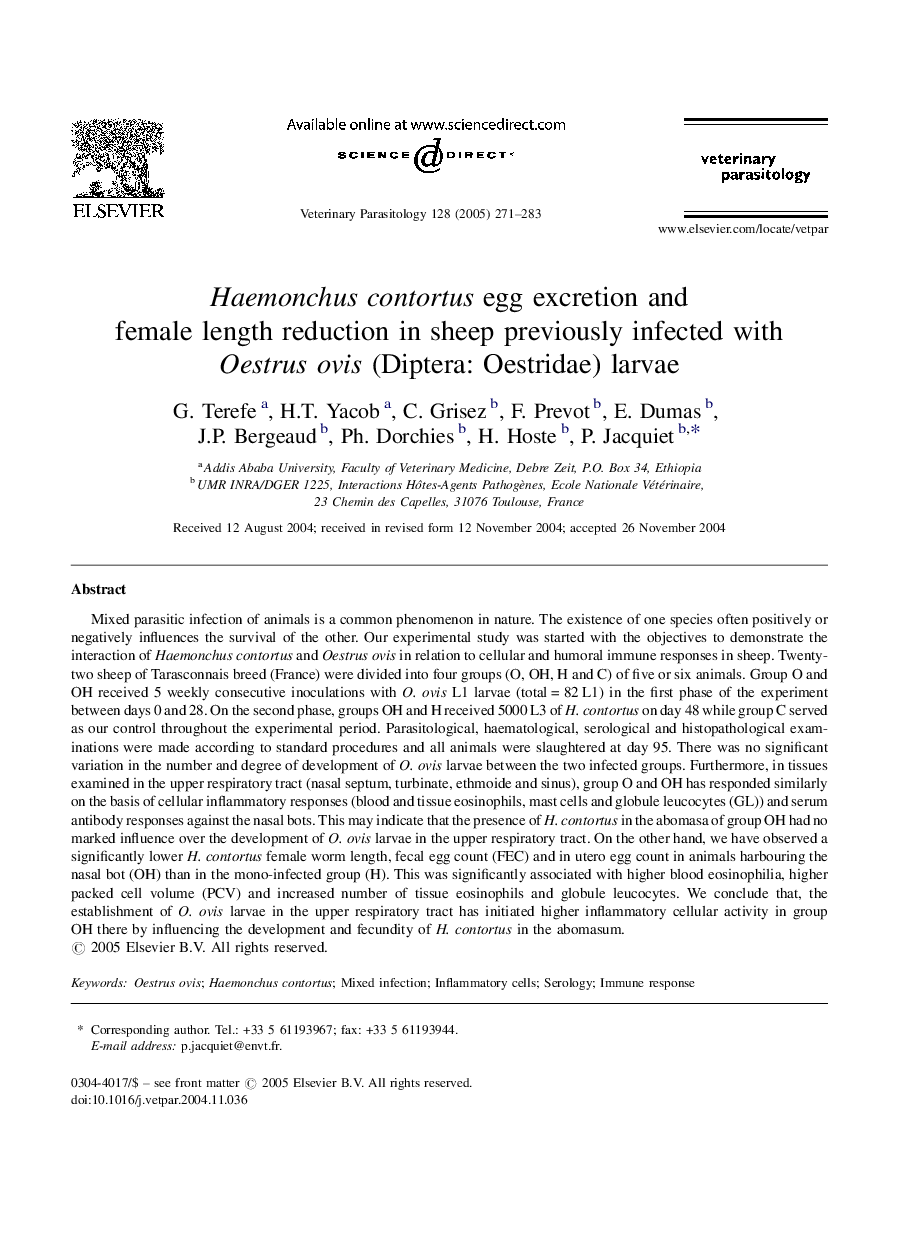| کد مقاله | کد نشریه | سال انتشار | مقاله انگلیسی | نسخه تمام متن |
|---|---|---|---|---|
| 8991320 | 1555812 | 2005 | 13 صفحه PDF | دانلود رایگان |
عنوان انگلیسی مقاله ISI
Haemonchus contortus egg excretion and female length reduction in sheep previously infected with Oestrus ovis (Diptera: Oestridae) larvae
دانلود مقاله + سفارش ترجمه
دانلود مقاله ISI انگلیسی
رایگان برای ایرانیان
کلمات کلیدی
موضوعات مرتبط
علوم زیستی و بیوفناوری
علوم کشاورزی و بیولوژیک
علوم دامی و جانورشناسی
پیش نمایش صفحه اول مقاله

چکیده انگلیسی
Mixed parasitic infection of animals is a common phenomenon in nature. The existence of one species often positively or negatively influences the survival of the other. Our experimental study was started with the objectives to demonstrate the interaction of Haemonchus contortus and Oestrus ovis in relation to cellular and humoral immune responses in sheep. Twenty-two sheep of Tarasconnais breed (France) were divided into four groups (O, OH, H and C) of five or six animals. Group O and OH received 5 weekly consecutive inoculations with O. ovis L1 larvae (total = 82 L1) in the first phase of the experiment between days 0 and 28. On the second phase, groups OH and H received 5000 L3 of H. contortus on day 48 while group C served as our control throughout the experimental period. Parasitological, haematological, serological and histopathological examinations were made according to standard procedures and all animals were slaughtered at day 95. There was no significant variation in the number and degree of development of O. ovis larvae between the two infected groups. Furthermore, in tissues examined in the upper respiratory tract (nasal septum, turbinate, ethmoide and sinus), group O and OH has responded similarly on the basis of cellular inflammatory responses (blood and tissue eosinophils, mast cells and globule leucocytes (GL)) and serum antibody responses against the nasal bots. This may indicate that the presence of H. contortus in the abomasa of group OH had no marked influence over the development of O. ovis larvae in the upper respiratory tract. On the other hand, we have observed a significantly lower H. contortus female worm length, fecal egg count (FEC) and in utero egg count in animals harbouring the nasal bot (OH) than in the mono-infected group (H). This was significantly associated with higher blood eosinophilia, higher packed cell volume (PCV) and increased number of tissue eosinophils and globule leucocytes. We conclude that, the establishment of O. ovis larvae in the upper respiratory tract has initiated higher inflammatory cellular activity in group OH there by influencing the development and fecundity of H. contortus in the abomasum.
ناشر
Database: Elsevier - ScienceDirect (ساینس دایرکت)
Journal: Veterinary Parasitology - Volume 128, Issues 3â4, 31 March 2005, Pages 271-283
Journal: Veterinary Parasitology - Volume 128, Issues 3â4, 31 March 2005, Pages 271-283
نویسندگان
G. Terefe, H.T. Yacob, C. Grisez, F. Prevot, E. Dumas, J.P. Bergeaud, Ph. Dorchies, H. Hoste, P. Jacquiet,